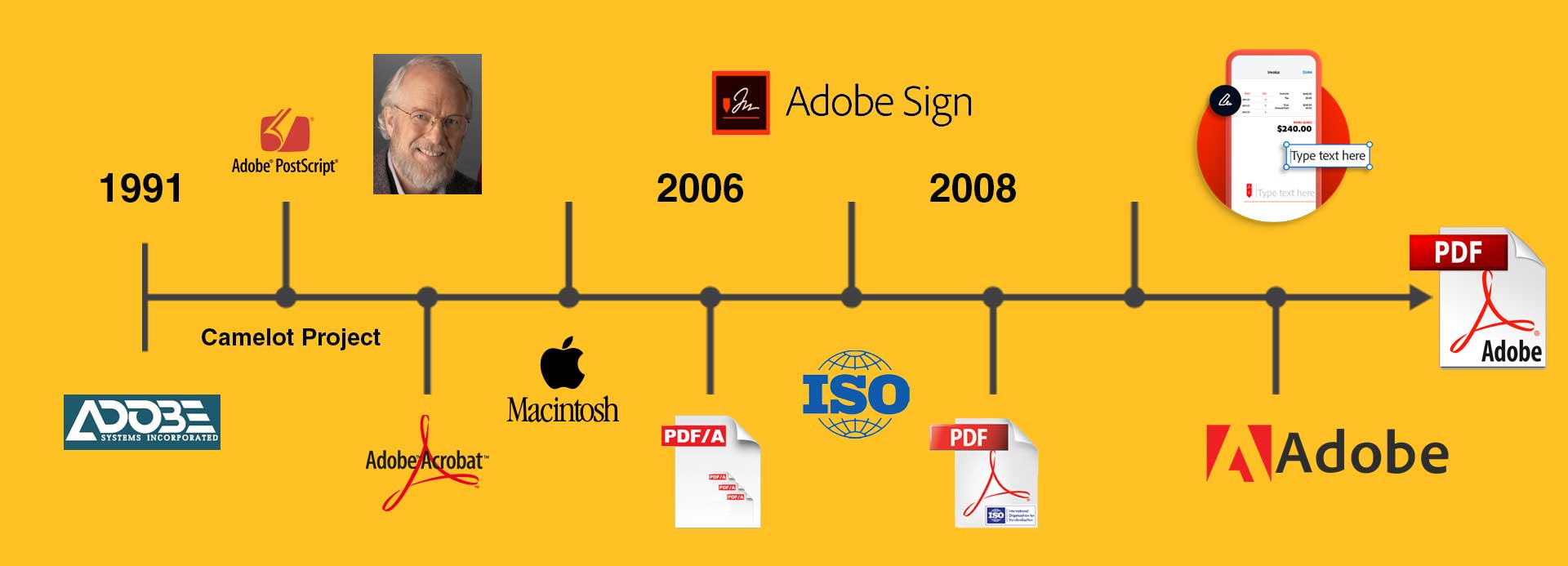
We use it on a daily based and maybe one or the other asked themselves, how did PDF become so famous and who is the genius behind this invention. In today’s infographic, we dig behind the history and see where PDF came from and why it gained so high popularity. Let us have a close look at the evolution of PDF.
PDF or in other words the portable document format is widely used across different operating systems, many languages, devices, and also peripheral equipment like printers to visualize information in a true layout.
The first time Adobe actually talked about this technology was at a Seybold conference in San Jose in 1991. At that time, it was referred to as ‘IPS’ which stood for ‘Interchange PostScript.’
Back in 1991, Adobe co-founder Dr. John Warnock worked on a concept paper called Camelot Project which launched the success of PDF. His intention was to generate a universal document format that captures document-centric information, independent from an application, operating system, or device. The goal was to have a format that can be viewed in a true layout, with the proper font used even if it is not installed on a device, and send this document easily between two parties.
By 1992, it was ready, Camelot had developed into PDF and in 1993 Adobe launched Adobe Acrobat Distiller, Exchange and Reader. Nearly 30 years later, it is the file format trusted by people and businesses around the globe. Let’s look under the hood at what PDF actually is.
PDF stands for Portable Document Format and essential we can say:
- It is essentially an electronic paper
- It can be viewed on any device
- It does not require specialized software or hardware.
- It preserves content and formatting
“This capability would truly change the way information is managed. [It] would save millions of dollars in document inventory costs.” said once John E.Warnock, co-founder and creator of PDF.
PDF evolved from an existing page description language called PostScript and was originally launched in a proprietary format. Back in 1993 Adobe launched its first version of Adobe Acrobat, the viewer, and builder of PDF documents as we can read in the Adobe Blog.
In 2007, it was released as an ISO open standard, which is when it gained in popularity, reference ISO 32000-1:2008.
You will ask yourself why was PDF created?
- To provide a universal way to communicate and view information electronically.
- To give industries a tool to share documents across any OS and machine
- Ultimately, to create a more efficient workflow.
Another question we see frequently, who uses PDF?
for example
- Legal professionals
- Educational sector
- HR professionals
- Real estate agents
- Insurance industry
- Financial institutions
What are the key features of a PDF?
- conversion of other formats into PDF
- creation of electronic documents
- editing of PDF documents and files
- annotation of PDF
- securing information and document content and PDF files themselves
- Long-term archiving
- e-signature and digital signature
- Optical Character Recognition (OCR)
What is the advantage of PDf compared to a paper?
- PDF Doesn’t take up any physical space vs PAPER Is cumbersome and requires filing cabinets
- PDF Can be easily found with a simple electronic search vs PAPER we can see 7.5% of all paper documents are lost, and 15% are misplaced
- PDF Takes 0 trees to produce 500 PDF pages vs PAPER Takes 2.4 trees to produce 500 sheets of paper
What is the advantage of PDF compared to a DOC format?
- PDF Format remains intact no matter what vs DOC Format can often change when printed or shared.
- PDF Works on any OS, regardless of software vs DOC MS Word must be downloaded and must run on the same version
- PDF Digital certificates and signatures may be added to secure files vs DOC can only be password protected (lower encryption levels than PDF)
Take into consideration that today’s version of PDF is divided into many sub-standards like PDF/A, which is following special specifications for long-term archival. Also, there is a substandard for PDF/E which is for engineering drawings. We can also for a standard in the pre-press area, PDF/X, which is separating the color layers for printing. There are also other variants like PDF/UA and PDF/VT.
Did you know, today more PDF get produced with Microsoft (34%) than with Adobe products, over 40% of all PDF have a single page only.
Also what many people did maybe also not know that 3D objects can be embedded into PDF and can be viewed with the free Adobe Reader.
Security:
Adobe added an e-signatures service to the Document Cloud and under the Acrobat pro program called Adobe Sign. Adobe Sign is in over 200 countries in the world as a legal digital signature recognized.


![Human Wonders Apollo 13 - Houston we have a Problem [Infographic] hero-image-Apollo-13-mission](https://www.skillzme.com/wp-content/uploads/2025/01/hero-image-Apollo-13-mission-200x200.jpg)
![Formula 1’s Highest-Paid Drivers 2024 [Infographic] hero-image-Formula1-Highest-Paid-Drivers-2024](https://www.skillzme.com/wp-content/uploads/2024/12/hero-image-Formula1-Highest-Paid-Drivers-2024-200x200.jpg)
![Salaries of Famous Scientists [Infographic] Salaries of Famous Scientists](https://www.skillzme.com/wp-content/uploads/2025/04/hero-image-Salaries-of-Famous-Scientists-200x200.jpg)


Recent Comments